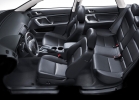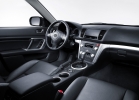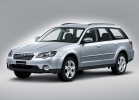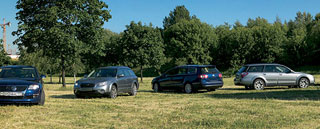Subaru Outback test drive 2006 - 2009 station wagon
Without options
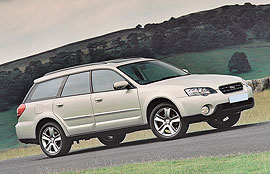 Stepwing station wagons can be counted on the fingers. Only three such models are presented in the secondary market today: Outbek, XC70 and Ollroud. At the time of purchase, Subaru among them is the most disadvantageous. But if you know how to count money, in the end you will choose it.
Stepwing station wagons can be counted on the fingers. Only three such models are presented in the secondary market today: Outbek, XC70 and Ollroud. At the time of purchase, Subaru among them is the most disadvantageous. But if you know how to count money, in the end you will choose it. A few years ago, it seemed that the universals of an increased cross -country future. Outbek, XC70 and the first generations were very popular. But in the end, the struggle for the sympathy of buyers was won by the SUVs of cars in essence the same, only outwardly similar to jeeps. They turned out to be more convenient to use and, in the eyes of most people, more prestigious. The classic country universals got a modest role of cars for intellectuals who do not accept the aggressive, rude image of jeeps.
Outbek is the most popular of this trinity. Created on the basis of a democratic legashi, it costs only a little more than CR-V and RAV4 with motors of the same volume. However, against the background of Honda and Toyota, this car is a completely different level much more solid and noble. Of course, with close acquaintance, medium -class origin becomes obvious. For riding comfort, spaciousness and decoration of the salon, Outbek clearly does not reach the XC70, and even more so to Ollroud. But the fact that he looks more expensive than his money is indisputable.
You can take an American
However, the popularity of Outbek is relative. In 20042005, only 1000,1500 cars per year were sold in Russia. As you know, in the secondary market cars with Russian registration do not make. They are, but they must be sought. Cars from Europe? Yes, they are taken in particular from mountain Switzerland, where Mark Subaru is very revered. But at the current course of Frank (and the euro too), good cars from Europe are expensive. If a European is fundamentally needed, it makes sense to take a 3-liter version 2.5-liter is a little cheaper than a new machine.
Therefore, the lion's share of offers in the market is cars from America, which are 70,000,000,000 rubles. Cheaper Europeans. According to mechanics, you can take an American. Only they have other lighting equipment and the frequency range of radio receivers, and the power system is configured for gasoline of a different composition. Therefore, do not be surprised if the Check Engine lamp periodically light up on the dashboard. As a rule, this is a false alarm and after removing an error from the computer, the check goes out. The main thing is that the American motor is not slaughtered by the resinous deposits of cheap mineral oil, Gutalin under the valve lid can destroy the engine.
As for the configuration, in Russia, even a 2.5-liter outback can be equipped with a maximum up to a leather cabin with electric regulations of a driver's seat. In imported machines, it is more often like this: the engine is two and five velor salon, three liters of leather. All Americans, of course, with automatic transmission.
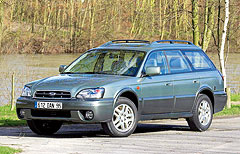 Old instead of the new
Old instead of the new The current Outbek has been produced since 2003. However, in the ads there are Americans of the previous generation, declared in 2004. Do not rush to blame the distillers of crook. For the American market, two generation cars were really produced for some time in parallel.
Machines of the previous model cost 40,00050,000 rubles. cheaper. But if you plan to ride a long time, buying his predecessor now hardly makes sense. In 23 years, it will be perceived, as the first -generation outback is now. See how much these cars cost in ads
Follow the oil level
Unlike Legashi, the outbuke is not equipped with a 2-liter engine, weakly weak for an all-terrain vehicle. Under the hood, at least a 2.5-liter opposite four with a capacity of 165 forces, the capabilities of which in most situations are enough. At the same time, 2.5-liter machines themselves are relatively inexpensive, and in operation they are not particularly burdensome.
Those who want to get more addressed a 3-liter 6-cylinder opposition as much as 245 forces. The motor, of course, is hurricane. However, a 3-liter outback is more than 2.5-liter on average by 120130 thousand, and the annual road tax on it is 24,500 rubles. Instead of 8250 rub. And this, by the way, is the cost of a large one with the replacement of many consumables.
Opposite motors Subaru are the same stubborn tribute to traditions as doors without window frames. This scheme does not give any advantages to the ordinary consumer. But due to tightness in the engine compartment, any service or repair operation becomes laborious and expensive. Fortunately, the motors turned out to be reliable and interventions in them are not often required. For example, the gaps in the valves, although they are regulated by the selection of the thickness of the pushers (for this you need to remove the engine), but according to the operating experience, at least up to 150,000 km remains normally.
The main thing is to monitor the level of oil. Being completely serviceable, Subaru motors can consume 100,200 ml/1000 km. There is nothing wrong with this other German engines to the oil even more greedy. It’s just that in the trunk you need to hold a liter jar of oil and get the probe at least every 3000 km. If you do not look at the motor from that to the next time you can no longer come for maintenance, but for major repairs.
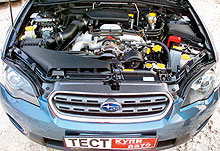 Engines in operation
Engines in operation The lights of the ignition are enough for an average of 30,000 km. On each third, it is advisable to prophylactically rinse the injectors and the throttle block. The belts of the auxiliary unit drive change as a condition usually to 80100 thousand. In machines operating in large cities where roads in winter are treated with aggressive chemistry, a radiator can flow. In this case, instead of the original plastic, it makes sense to establish a more reliable Russian -made aluminum, which with the consent of the Japanese is offered by dealers of Subaru.
2.5 liters
The timing engine is given a belt that is supposed to be changed after 100,000 kilometers. Since this operation is time -consuming, it makes sense to replace the crankshaft and camshaft oil seals. But the belt rollers (they are not cheap at all) by the time of its first replacement can be still quite alive. In this case, they can be left another 100,000 km.
3.0 liters
Here, in the drive of the timing, a chain is used, which does not require attention to at least 200,000 km. But the condition of the roller of the tensioner belt of the auxiliary units must be controlled on each. If he began to hang out, change without delay otherwise the consequences can be much more serious. After 100 thousand mileage, a water pump can flow, the work on replacing which will go out in a penny.
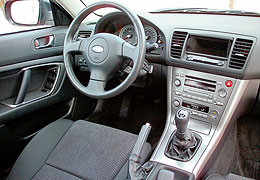 Four -speed automatic requires checking
Four -speed automatic requires checking Buyers of a 2.5-liter outback can choose between a manual and automatic box. Like other Subaru universals, the mechanics are equipped with a lowering gear with a gear ratio of 1.45. It is not intended for heavy off -road (as well as the outbuke itself), however, it allows you to save the adhesion when towing the trailer in the mountains or when trying to move off in the soft ground.
The manual box itself is reliable. All that is required of you is to change oil in it after 60 thousand. But the clutch can begin to publish rod or squeak at idle long before the wear of the driven disk (it serves an average of 90,000120,000 km). This is due to a violation of the center of the disk relative to a cunning two -mass flywheel. If this happens, you can install an ordinary single -mass flywheel along with the corresponding set of clutch. It will not turn on so smoothly, but solve the problem with extraneous sounds.
The machine for 2.5-liter machines, unfortunately, remained 4-speed as slow as before. But for the buyer of a used car, not thoughtfulness is more important, but the operability of the box. On the machines of 20032006, it was not hard enough. If the previous owner traveled aggressively or dragged a heavy trailer, jerks may appear by 100,000 mileage during switching. For some time, they can be eliminated by the correction of electronic automatic transmission settings. But in the end, the box will still have to repair the good, it successfully lends itself to restoration.
When the Japanese revealed the problem, they first reduced the oil replacement interval in all machines from 60,000 to 30,000 km, and by 2007 the model year was made to the 4-speed box of changes. Therefore, when buying a 2.5-liter machine of early issues, the automatic transmission must be diagnosed especially carefully. But even if the box is completely serviceable, in the future it should be treated carefully.
But on 3-liter Subaru, a new 5-speed automatic is used much more adequate in behavior and absolutely trouble-free. However, this does not mean that the purchase of a 2.5-liter outback with the automatic transmission should be refused. Even if you have to sort out the box (which is not a fact at all), the cost of repair will be less than 130 thousand, which must be immediately overpayed for a 3-liter version.
Depending on the type of transmission, various drive schemes are used on outbuke. Most drivers will not feel the difference, but among the buyers of Subaru there are many enthusiasts for whom the nuances in the behavior of the car are fundamental. On cars with a manual box, all four wheels are constantly driven. The center differential distributes the moment between the front and the rear axle in a ratio of 50:50 and, if necessary, it is softly blocked by the WISKOFTA.
The machine involves a constant front wheel drive with automatic rear connecting. The difference is that on machines without a system of dynamic stabilization a multi -disc clowing can transfer a maximum of 50% of the moment, and in the presence of VDC, the planetary gearbox sends 55% of the thrust to the stern. And although the automation in any case is configured so that the rear wheels are picked up without delay, an experienced driver on a slippery road will like a VDC car more. For 3-liter outbacks, it is mandatory, and for 2.5-liter options.
In operation, the all -wheel drive transmission is absolutely trouble -free, and its maintenance is reduced to a replacement after 60,000 km of oil in the anterior and rear gearboxes. If the machine is equipped with mechanics, the front gearbox is combined with a gearbox.
Silent blocks have become stronger
At first, in the front suspension of the outbreak there was one weak place the rear silent blocks of levers rushed to 4560 thousand mileage. Changing two gum is small problem. Nevertheless, the Japanese have changed their design, and now parts of a new sample are delivered to spare parts, which go up to 90 thousand.
The remaining details of the chassis last for a long or long time. For example, the rear levers on the natural due to the nose have never changed. You can, of course, complain about the high cost of the rear shock absorbers with auto -boat, which do not allow the stern to sag under load. But for the station wagon, this is a very useful function, and if such shock absorbers honestly work out 100,000 km, it is quite possible to agree with their price.
There are no problems with the brakes too. Salpers from dirt do not wedge. The front pads serve an average of 20,00030,000 km, the rear ones are almost twice as long. Disks withstand two sets of pads, but when overheating they can be deformed. But if vibration appears on the pedals during braking, the pitching of the disks, as a rule, solves the problem.
So Outbek’s chassis is quite strong. If you take a machine with a mileage up to 100,000 km, in the next 5060 thousand you will have to change not so many details: brake discs, shock absorbers and stabilizers racks. Perhaps one or two hub bearings and some steering traction or tip. All these expenses are predicted and not catastrophic.
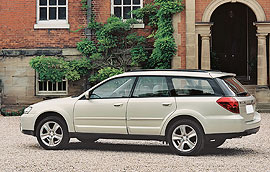 Buy?
Buy? When you buy a new one, everything is clear here. It costs much cheaper than its European analogues of KhS70 and OLRUDA, and therefore is in demand. However, with age, Subaru loses in price slower than Europeans and against their background it becomes less attractive. Americans of 20042005 of the production with a 2.5-liter engine cost an average of 620,000720,000 rubles, and with a 3-liter 730,000850,000 rubles. To navigate in prices for Europeans, add 90110 thousand to these numbers.
That is, the 34-year-old Subaru is practically compared at a price with Volvo of the same age, and Audi becomes most expensive for some 1012%. It would seem, what's the point of taking a used outback when for the same money you can become the owner of a much more prestigious car?
Meaning in reliability. The only possible problems of a used outbeck is an automatic box of a 2.5-liter version. In all other respects, this is a hardy and trouble-free car, which at the age of 35 should not cause special trouble and large expenses.
At one time, I collected statistics on XC70 and Ollroud and I can say that with age they become moody and expensive in operation. Therefore, if you need a country universal and you are going to buy it not new, then the outback seems to be definitely the best choice. Without options.
Body and salon: no problems
It is too early to talk about corrosion, and from minor damage to the Outbek body is reliably protected by a developed plastic belt around the lower perimeter. Yes, the car has long front and rear overhangs. But if, outside the asphalt, to be neat, all -wheel drive and road clearance in 195 mm allow you to get out into nature, without causing a damage to the car.
With internal equipment, too, no problems applying for statistics. Like most Japanese cars, Subaru is made very soundly.
Alexander Konov, photo of Maxim Goncharov and Subaru
A source: Magazine buy a car [05/2008]

